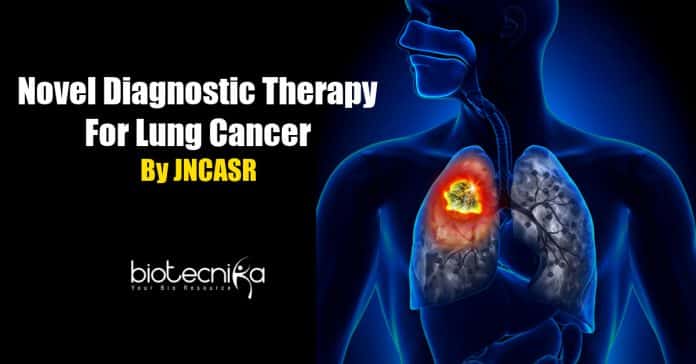Novel diagnostic therapy for Lung Cancer by JNCASR scientists
One of the most common causes of cancer-related death globally is due to Lung cancer. It is really is difficult to detect during the initial stages, making it challenging to treat lung cancer. A diagnostic treatment for lung cancer paving way for personalized drugs has been discovered by scientists.
A drug candidate – theranostics (diagnostic therapy) for lung cancer was developed by scientists from JNCASR – DST.
The study was jointly supported by SwarnaJayanti Fellowship Grant, BRICS Multilateral R&D Projects grant, and DST. The outcome of the research is released in the journal Theranostics. In the advancement of theranostics for cancer, imaging of oncogene specific non-canonical DNA secondary structures (G-quadruplex-GQ structures) and the selective recognition have a great assurance, and additionally, due to its structural dynamics and diversity, it has been very challenging.
A small molecule for selective recognition of BCL-2 GQ was developed by Professor T. Govindaraju, together with his team from JNCASR.
By turn on fluorescence recognition of BCL-2 GQ through its anti-lung cancer activity and tissue imaging potential, and unique hybrid binding mode, the JNCASR group described the theranostic task of TGP18 molecule. In in-vivo capitalization on genome
instability and the gains of oxidative stress to kill lung cancer cells were led by their strategy of specific topology recognition with hybrid mode. And also, at the lower edge of the far-red to NIR spectroscopic window, the TGP18 molecule having a turn on emissions band, which showed to be a viable probe for the imaging of tumor cells. Jointly, theranostic agent TGP18 with excellent biocompatibility showed in vivo inhibition as well as tissue imaging, suggesting the outstanding clinical translational possibility.A broad range of cellular processes, comprising the expression of many oncogenes is controlled by G-quadruplexes (GQs) – non-canonical DNA secondary structures. GQs are considered as a promising chemotherapeutic target, as stabilization in cancer cells of GQs leads to replication stress and DNA damage accumulation. There are no concerted reports on small molecule theranostics, in spite of the considerable attempts to merge therapeutic and diagnostic properties. Likewise, there are no molecules discovered for the topology selective recognition of myriad of G-quadruplexes, specifically oncogenic G-quadruplexes.
The selective recognition coming from the distinctive loop structure of G-quadruplexes that modifies the total binding affinity and probe interaction was revealed by this research, and by inducing death in cancer cells, TGP18 binding to anti-apoptotic BCL-2 GQ induces anticancer activity and ablates the pro-survival role. In in-vivo xenograft and in-vitro 3D spheroid culture models of lung and breast cancer, the intervention of G-quadruplexes mediated lethality by TGP18 translated into anti-cancer activity. The function of TGP18 in G-quadruplexes-targeted cancer theranostics is defined by the in vivo therapeutic efficacy, supplemented with tissue imaging potential and tumor 3D spheroid.
Compared to anticancer medicine gemcitabine at an increased dose of 100 mg/kg, a notably reduced dose of TGP18 (0.5 mg/kg) exhibited anti-lung tumor activity, as per the outcomes of the study.
As observed by its far-red imaging of the tumor tissue, the TGP18 was found to reach the target tumor site.
Theranostic drugs specifically for cancer with huge significance in the personalized drug can be developed by this method.
Author: Sruthi S






























